Difference between revisions of "Highly Effective Construction of Thematic Maps"
| (73 intermediate revisions by 3 users not shown) | |||
| Line 1: | Line 1: | ||
| − | '''OpenJUMP Tutorial by Thomas Brown''' |
+ | '''OpenJUMP Tutorial by Thomas Brown - Revised by Didier Soeharjono and Erika Cizek''' |
| − | ==Introduction |
+ | ==Introduction== |
| + | ===About OpenJUMP=== |
||
| + | OpenJUMP is a Free and Open Source Software for Geospatial (FOSS4G) that is similar to other popular Geographic Information Systems (GIS) such as ArcGIS or QGIS. Originally founded by Vivid Solutions in 2002, this software was formerly known as JUMP (Java Unified Mapping Platform) before being discontinued in 2006. Since then, it has been renamed as OpenJUMP in recognition to the original Canadian development team, but also due to the fact that further contribution is open to the public. Nowadays, maintenance efforts are accomplished through The JUMP Pilot Program (JPP), an association committed to coordinating its development. The JPP consists of various separate organizations and global volunteer developers. |
||
| + | '''Languages''' |
||
| − | OpenJUMP is a Free and Open Source Software for Geospatial (FOSS4G) program that can be downloaded from http://openjump.org/. It is an excellent software package that is similar to other commonly using Geographic Information Systems (GIS) like ArcGis or Quantum GIS. The feature that really sets it apart from other programs is that the main focus of its tools and functionality leans more towards style. This tutorial will demonstrate the construction of a common thematic map like the one shown in Figure 1.1 below using OpenJump. |
||
| + | *Tamil |
||
| + | *French |
||
| + | *Czech |
||
| + | *Finnish |
||
| + | *Italian |
||
| + | *English |
||
| + | *Portuguese |
||
| + | *Telugu |
||
| + | *Malay |
||
| + | *Brazilian |
||
| + | *Portuguese |
||
| + | *Chinese (Simplified) |
||
| + | *German |
||
| + | *Japanese |
||
| + | *Spanish |
||
| + | *Hungarian |
||
| + | '''Intended Audience''' |
||
| − | <center>[[Image:Figure1.1.jpg|300px]]</center> |
||
| + | *Non-Profit Organizations |
||
| + | *Government |
||
| + | *Science/Research |
||
| + | *Developers |
||
| + | *End Users/Desktop |
||
| + | *Agriculture |
||
| + | '''User Interface''' |
||
| − | ''Figure 1.1 shows a thematic map built and styled in OpenJUMP'' |
||
| + | *Java Swing |
||
| + | |||
| + | '''Programming Language''' |
||
| + | *Java |
||
| + | |||
| + | ===Capabilities=== |
||
| + | *Cross-platform compatibility with Windows, Linux, Unix, MacOSX (with Java installed) |
||
| + | *Read & write the following vector file formats: CSV, DXF, GeoJSON, GML, JML, OSM, SHP and more |
||
| + | *Read & write the following raster file formats: ASC, BMP, DCX, ECW, GeoTIFF, GIF, JPEG, PNG, TIFF and more |
||
| + | *Read recognized data formats from compressed files (zip, tar, tar.gz, tar.bz and more) |
||
| + | *Database access: read ArcSDE, MySQL, Oracle, PostGIS, SpatialLite & write PostGIS |
||
| + | **Note: Compatibility with certain file formats may require an additional plugin |
||
| + | *BeanShell & Python consoles allows to script |
||
| + | *Tools include: Queries, Analysis, Statistics, Generate, Warp, QA, Measure & more |
||
| + | *Availability of various third-party extension plugins |
||
| + | *Allows to store, edit, process, analyze & display spatial data |
||
| + | |||
| + | ===Why use OpenJUMP?=== |
||
| + | The feature that really sets it apart from other programs is that the main focus of its tools and functionality leans more towards style through the ease of editing geometry and attribute data. Additionally, its friendly layout results in a rapid learning curve. |
||
| + | |||
| + | ===Purpose=== |
||
| + | This tutorial will demonstrate the construction of a common thematic map displaying the land use throughout Ottawa in OpenJUMP (such as the one shown in Figure 1.1). In contrast to reference maps which focus on physical features, a thematic map has the main goal of displaying a particular theme in an area. These maps can be seen as an infographic that communicates information to the viewer. Some examples of thematic maps include [http://wiki.gis.com/wiki/index.php/Choropleth_map choropleth maps], [http://wiki.gis.com/wiki/index.php/Dot_density_map dot density maps], and [http://wiki.gis.com/wiki/index.php/Proportional_symbol_map proportional symbol maps]. As seen in this exercise, their production in GIS software requires stacking multiple data layers together and then modifying the map’s appearance in order to enhance the visualization of the thematic data. Throughout this process, the user will determine various potentials linked to this software through editing the attributes and symbology of the provided data. Furthermore, it will help become more familiar with this user-friendly open source GIS. |
||
| + | |||
| + | |||
| + | <center>[[Image:them_map.png|700px|]]</center> |
||
| + | |||
| + | |||
| + | <center>''Figure 1.1 shows a thematic map built and styled in OpenJUMP''</center> |
||
| + | |||
| + | =='''The Process'''== |
||
| + | |||
| + | ===Obtaining OpenJUMP and data=== |
||
| + | <u>Step 1: Downloading OpenJUMP</u> |
||
| + | <br> |
||
| + | OpenJUMP can be downloaded through the following link [https://sourceforge.net/projects/jump-pilot/] by clicking the green ‘Download’ button. |
||
| + | <br> |
||
| + | <br> |
||
| + | <u>Step 2: Downloading the data</u> |
||
| + | <br> |
||
| + | The Ottawa Thematic Data can be downloaded through the following link [https://library.carleton.ca/find/gis/geospatial-data/ottawa-thematic-data] by clicking the red 'Land Use 2010 - Direct Download' link. |
||
| + | <br> |
||
| + | <b>Note: Since this data is from a licensed dataset, it is only available to Carleton students, staff and faculty.</b> |
||
| + | |||
| + | ===Starting OpenJUMP and importing data=== |
||
| + | <u>Step 3: Starting OpenJUMP</u> |
||
| + | <br> |
||
| + | OpenJUMP starts up by clicking the [[File:OJ Thumbnail.png]] icon, the main screen shown in Figure 1.2 should appear shortly after. |
||
| + | <br> |
||
| + | <br> |
||
| + | <u>Step 4: Importing the data</u> |
||
| + | <br> |
||
| + | Adding files is done by using the folder icon circled in red as seen in Figure 1.2. In this case, we will be importing the 'LandUse_2010.shp' file which can be found where the previously downloaded data was saved. Right now would be a good time to save your project by clicking on the <u>'File'</u> tab and then the <u>'Save Project As'</u> button. |
||
| + | <br> |
||
| + | <b>Note: it is important to save your project frequently to avoid losing any progress.</b> |
||
| + | |||
| + | <center>[[Image:Figure1.2.jpg|700px|]]</center> |
||
| + | |||
| + | <center>''Figure 1.2 shows the starting interface of OpenJUMP and highlights the icon for importing files.''</center> |
||
| + | <br> |
||
| + | |||
| + | ===Manipulating the data=== |
||
| + | <u>Step 5: Extracting the data</u> |
||
| + | <br> |
||
| + | The <b>'LandUse_2010'</b> data will appear as one single layer even though it consists of mulitple attributes. This results with the image being displayed in one single color, even though our goal is to portray each land use type by different colors. To achieve this, click on the <u>'Edit'</u> tab, then scroll over <u>'Extract'</u> before choosing the <u>'Extract Layer by attribute'</u> button. In the pop-up window, select <b>'LU_2010'</b> as the attribute. This will result with the creation of a new folder named <b>'Extract'</b> in the content pane which shows each attribute as a single layer. |
||
| + | <br> |
||
| + | <center>[[Image:Before_extract.png|700px|]]</center> |
||
| + | |||
| + | <center>''Figure 1.2 Image before using the 'Extract layer by attribute' tool''</center> |
||
| + | <br> |
||
| + | <center>[[Image:After_extract.png|700px|]]</center> |
||
| + | |||
| + | <center>''Figure 1.3 Image after using the 'Extract layer by attribute' tool''</center> |
||
| + | <br> |
||
| + | <u>Step 6: Reclassifying land use layers</u> |
||
| + | <br> |
||
| + | By referring to the <b>'LandUse_2010_Legend.xlsx'</b> Microsoft Excel file that comes in the downloaded data folder, we can classify the land use layers into 9 different types. Each layers will be reclassified into the following categories: |
||
| + | *<b>Residential:</b>R1; R2; R3; R3-S; R4-x; R4; R5 |
||
| + | *<b>Commercial:</b>C1; C2; C3; OF |
||
| + | *<b>Industrial:</b>M1; M2 |
||
| + | *<b>Institutional:</b>I1; I2; I3; I3-r; I4; I5 |
||
| + | *<b>Recreational:</b>RE-A; RE-A-s; RE-p; RE-p-s |
||
| + | *<b>Utilities:</b>TR; UT; COMM; ST |
||
| + | *<b>Water:</b>Water; IW |
||
| + | *<b>Landcover:</b>OS; AG; FT; QS; ROS; WL; WL-FT |
||
| + | *<b>Other:</b>V1; V2 |
||
| + | <br> |
||
| + | To do so in OpenJUMP, we can select the appropriate layers for each category then right-click and choose the <u>'Combine selected layers'</u> button. This will combine all the selected layers into a single one (located at the bottom of the panel), which we will then rename the newly created <b>'Combined'</b> layer to the appropriate category name by double-clicking on its label. Repeat this process until you have created 9 reclassified and renamed categories. Move the combined category set of layers to the top (so that these layers are visible on the map) by selecting the 'Result' folder and selecting <u>'Move Category to Top'</u>. If you are having issues with the software lagging at this point, you can select the original (uncombined) layers, right click, then click <u>'Remove Selected Layers'</u> to get rid of them (you will only be working with the combined layers from now on). |
||
| + | <br> |
||
| + | <br> |
||
| + | <u>Step 7: Changing the layers style</u> |
||
| + | <br> |
||
| + | In order to change the color symbolization of the layers, we will start by selecting each reclassified layers one by one, right clicking, hovering over <u>'Styles'</u>, and clicking on the <u>'Change styles'</u> button (painting palette icon). In the pop-up window, click on the <u>'Colour theming'</u> tab and then uncheck the <u>'Enable colour theming'</u> box. Now return back to the <u>'Rendering'</u> tab, before changing the <u>'Fill'</u> to a more appropriate color for each reclassified layer. |
||
| + | <br> |
||
| + | <center>[[Image:Changestyle.png|700px|]]</center> |
||
| + | |||
| + | <center>''Figure 1.4 How to navigate to 'Change Styles' in OpenJUMP''</center> |
||
| + | <br> |
||
| + | <u>Step 8: Adding map elements</u> |
||
| + | <br> |
||
| + | In order to add some map elements to your image, you must access the 'Printer' tool located at the upper right side of the display. From there, you can add a title, scale, border, north arrow, legend and more by clicking on the <u>'Furniture'</u> button. |
||
| + | |||
| + | <center>[[Image:Finalzz.png|700px|]]</center> |
||
| + | |||
| + | <center>''Figure 1.5 Final land cover map of Ottawa.''</center> |
||
| + | |||
| + | =='''Styled Layer Descriptor'''== |
||
| + | Since shapefiles in general do not store visual elements, once a GIS software is closed and reopened all of those styling elements are deleted. The Styled Layer Descriptors (SLD) option retains style information into a layer, which can be imported and exported in OpenJUMP. These files are not only useful for maintaining style in OpenJUMP since they are written in Extensible Markup Language (XML); they are universally useful for styling webmaps. To build an SLD simply right click on the layer in the table of contents and select Style->Save Style as SLD File (red circle in Figure 1.6). From there the SLD file is stored and can be imported into a layer at any point using the Style->Import SLD File option from the same menu (blue circle in Figure 1.6). |
||
| + | |||
| + | <center>[[Image:Figure3.1.jpg|400px|]]</center> |
||
| + | |||
| + | <center>''Figure 1.6 How to navigate to the SLD option.''</center> |
||
| + | |||
| + | <<center>[[File:Exportstyle img.png|400px]]</center> |
||
| + | |||
| + | <center>''Figure 1.7 In some versions of OpenJUMP the option to export SLD file is actually shown as "Export style".''</center> |
||
| + | |||
| + | =='''Adding an Inset Map'''== |
||
| + | Inset maps are often used in thematic mapping in order to show a more dense area in greater detail, or to show the location of an area in a regional or global context. With the land use in Ottawa, an inset map is very useful in showing the more densely fragmented downtown core of the city in greater detail. Here is how you go about making one in QGIS using the layers you created in OpenJUMP. |
||
| + | |||
| + | <u>Step 1: Saving each layer</u> |
||
| + | <br> |
||
| + | Save and export each of the combined layers you created by right clicking on each layer and selecting <u>'Save Dataset As'</u>. |
||
| + | <br> |
||
| + | <br> |
||
| + | <u>Step 2: Setting up in QGIS</u> |
||
| + | <br> |
||
| + | Open QGIS. In the Browser panel, navigate to your directory, select each layer that you just exported and drag them down to the Layers panel below. You may need to edit the colours for each layer. To do so, right click on the layer and click <u>'Properties'</u>. Then select an appropriate colour in the Color field. Click ok. |
||
| + | <br> |
||
| + | <br> |
||
| + | <u>Step 3: Print Layout</u> |
||
| + | <br> |
||
| + | In the toolbar at the top of the window, click on <u>'New Print Layout'</u> [[File:Newprintlayout.jpg]]. Select a name for your print layout. In the toolbar on the left of the window that has just opened, click on <u>'Add a New Map to the Layout'</u> [[File:Addnewmap.jpg]], and click and drag your mouse over the layout viewer to cover the page. Your map should appear. |
||
| + | <br> |
||
| + | <br> |
||
| + | <u>Step 4: Adding your inset</u> |
||
| + | <br> |
||
| + | Go back to the original map viewer, and zoom in on the downtown core of Ottawa. Then go back to the layout viewer, and once again click on the <u>'Add a New Map to the Layout'</u> icon. This time, instead of dragging your map across the entire layout, draw your rectangle in a blank corner of your map. The zoomed in section of downtown Ottawa should appear in the inset. |
||
| + | <br> |
||
| + | <br> |
||
| + | <u>Step 5: Indicating extent</u> |
||
| + | <br> |
||
| + | In order to show the viewer which area the inset map is showing, we must indicate the extent of the inset. In the Items panel on the right side of the layout view, click on Map 1 (the overview of Ottawa). Click on the <u>'Item Properties'</u> tab below, and scroll down to Overviews. There, click on the green plus sign, and select Map 2 in the Map frame field. A red rectangle should appear on your main map, showing the extent of your inset. From here you can add any map elements that you deem fit, including a title, north arrow, legend, or scale bar. You can do this by clicking on <u>'Add Item'</u> at the top of the layout viewer and selecting the map elements of your choice. |
||
| + | <center>[[Image:Finallayout.jpg|700px]]</center> |
||
| + | <center>''Figure 1.8 The final thematic map including the inset map.''</center> |
||
| + | |||
| + | =='''Conclusion'''== |
||
| + | |||
| + | You are now able to successfully create a thematic map in OpenJUMP and save SLD files for future styling. With the various tools presented in this tutorial, you have now become familiar with a new open GIS software all while gaining knowledge to effectively create a thematic map. |
||
| + | |||
| + | <center>'''Thanks for Reading my Tutorial'''</center> |
||
| + | <center>[[Image:Figure3.3.gif|400px|]]</center> |
||
| + | [http://www.animationbuddy.com/animal/Animals/Other_Animals/0/18/ Kangaroo GIF] |
||
| + | |||
| + | References from: |
||
| + | http://www.openjump.org/jpp.html |
||
| + | https://sourceforge.net/projects/jump-pilot/ |
||
Latest revision as of 10:51, 4 October 2020
OpenJUMP Tutorial by Thomas Brown - Revised by Didier Soeharjono and Erika Cizek
Contents
Introduction
About OpenJUMP
OpenJUMP is a Free and Open Source Software for Geospatial (FOSS4G) that is similar to other popular Geographic Information Systems (GIS) such as ArcGIS or QGIS. Originally founded by Vivid Solutions in 2002, this software was formerly known as JUMP (Java Unified Mapping Platform) before being discontinued in 2006. Since then, it has been renamed as OpenJUMP in recognition to the original Canadian development team, but also due to the fact that further contribution is open to the public. Nowadays, maintenance efforts are accomplished through The JUMP Pilot Program (JPP), an association committed to coordinating its development. The JPP consists of various separate organizations and global volunteer developers.
Languages
- Tamil
- French
- Czech
- Finnish
- Italian
- English
- Portuguese
- Telugu
- Malay
- Brazilian
- Portuguese
- Chinese (Simplified)
- German
- Japanese
- Spanish
- Hungarian
Intended Audience
- Non-Profit Organizations
- Government
- Science/Research
- Developers
- End Users/Desktop
- Agriculture
User Interface
- Java Swing
Programming Language
- Java
Capabilities
- Cross-platform compatibility with Windows, Linux, Unix, MacOSX (with Java installed)
- Read & write the following vector file formats: CSV, DXF, GeoJSON, GML, JML, OSM, SHP and more
- Read & write the following raster file formats: ASC, BMP, DCX, ECW, GeoTIFF, GIF, JPEG, PNG, TIFF and more
- Read recognized data formats from compressed files (zip, tar, tar.gz, tar.bz and more)
- Database access: read ArcSDE, MySQL, Oracle, PostGIS, SpatialLite & write PostGIS
- Note: Compatibility with certain file formats may require an additional plugin
- BeanShell & Python consoles allows to script
- Tools include: Queries, Analysis, Statistics, Generate, Warp, QA, Measure & more
- Availability of various third-party extension plugins
- Allows to store, edit, process, analyze & display spatial data
Why use OpenJUMP?
The feature that really sets it apart from other programs is that the main focus of its tools and functionality leans more towards style through the ease of editing geometry and attribute data. Additionally, its friendly layout results in a rapid learning curve.
Purpose
This tutorial will demonstrate the construction of a common thematic map displaying the land use throughout Ottawa in OpenJUMP (such as the one shown in Figure 1.1). In contrast to reference maps which focus on physical features, a thematic map has the main goal of displaying a particular theme in an area. These maps can be seen as an infographic that communicates information to the viewer. Some examples of thematic maps include choropleth maps, dot density maps, and proportional symbol maps. As seen in this exercise, their production in GIS software requires stacking multiple data layers together and then modifying the map’s appearance in order to enhance the visualization of the thematic data. Throughout this process, the user will determine various potentials linked to this software through editing the attributes and symbology of the provided data. Furthermore, it will help become more familiar with this user-friendly open source GIS.
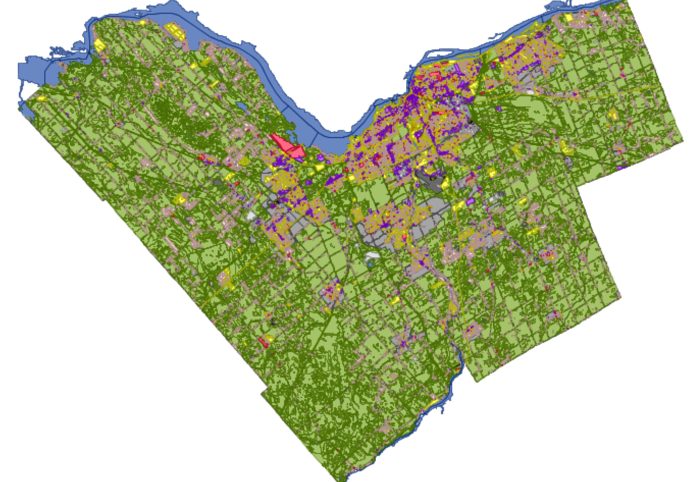
The Process
Obtaining OpenJUMP and data
Step 1: Downloading OpenJUMP
OpenJUMP can be downloaded through the following link [1] by clicking the green ‘Download’ button.
Step 2: Downloading the data
The Ottawa Thematic Data can be downloaded through the following link [2] by clicking the red 'Land Use 2010 - Direct Download' link.
Note: Since this data is from a licensed dataset, it is only available to Carleton students, staff and faculty.
Starting OpenJUMP and importing data
Step 3: Starting OpenJUMP
OpenJUMP starts up by clicking the  icon, the main screen shown in Figure 1.2 should appear shortly after.
icon, the main screen shown in Figure 1.2 should appear shortly after.
Step 4: Importing the data
Adding files is done by using the folder icon circled in red as seen in Figure 1.2. In this case, we will be importing the 'LandUse_2010.shp' file which can be found where the previously downloaded data was saved. Right now would be a good time to save your project by clicking on the 'File' tab and then the 'Save Project As' button.
Note: it is important to save your project frequently to avoid losing any progress.
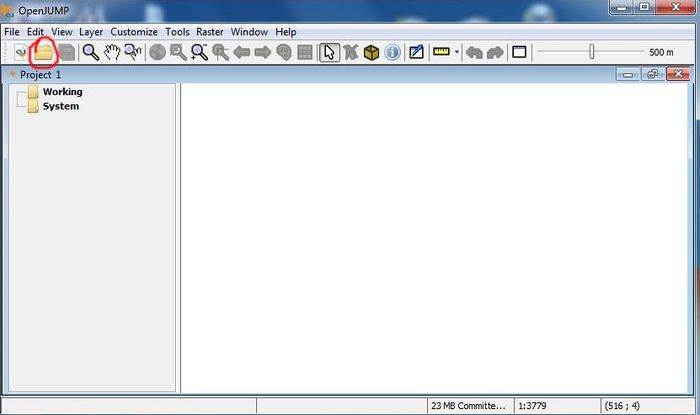
Manipulating the data
Step 5: Extracting the data
The 'LandUse_2010' data will appear as one single layer even though it consists of mulitple attributes. This results with the image being displayed in one single color, even though our goal is to portray each land use type by different colors. To achieve this, click on the 'Edit' tab, then scroll over 'Extract' before choosing the 'Extract Layer by attribute' button. In the pop-up window, select 'LU_2010' as the attribute. This will result with the creation of a new folder named 'Extract' in the content pane which shows each attribute as a single layer.
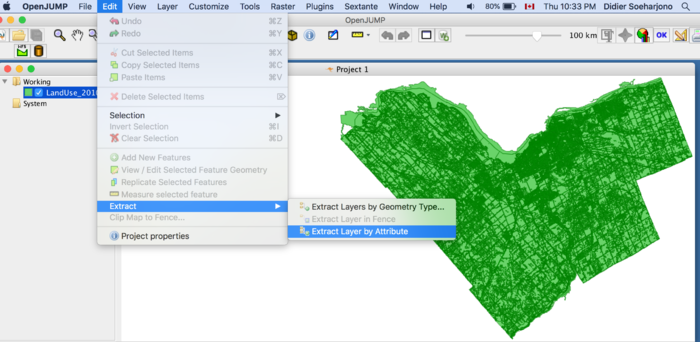
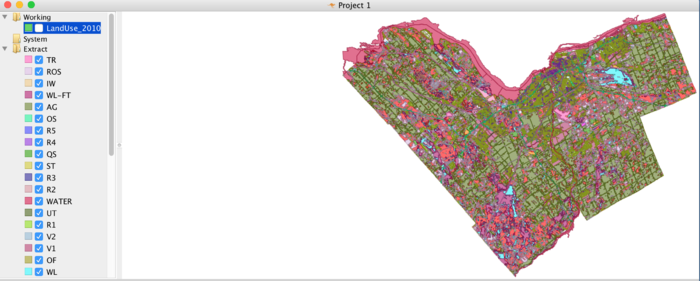
Step 6: Reclassifying land use layers
By referring to the 'LandUse_2010_Legend.xlsx' Microsoft Excel file that comes in the downloaded data folder, we can classify the land use layers into 9 different types. Each layers will be reclassified into the following categories:
- Residential:R1; R2; R3; R3-S; R4-x; R4; R5
- Commercial:C1; C2; C3; OF
- Industrial:M1; M2
- Institutional:I1; I2; I3; I3-r; I4; I5
- Recreational:RE-A; RE-A-s; RE-p; RE-p-s
- Utilities:TR; UT; COMM; ST
- Water:Water; IW
- Landcover:OS; AG; FT; QS; ROS; WL; WL-FT
- Other:V1; V2
To do so in OpenJUMP, we can select the appropriate layers for each category then right-click and choose the 'Combine selected layers' button. This will combine all the selected layers into a single one (located at the bottom of the panel), which we will then rename the newly created 'Combined' layer to the appropriate category name by double-clicking on its label. Repeat this process until you have created 9 reclassified and renamed categories. Move the combined category set of layers to the top (so that these layers are visible on the map) by selecting the 'Result' folder and selecting 'Move Category to Top'. If you are having issues with the software lagging at this point, you can select the original (uncombined) layers, right click, then click 'Remove Selected Layers' to get rid of them (you will only be working with the combined layers from now on).
Step 7: Changing the layers style
In order to change the color symbolization of the layers, we will start by selecting each reclassified layers one by one, right clicking, hovering over 'Styles', and clicking on the 'Change styles' button (painting palette icon). In the pop-up window, click on the 'Colour theming' tab and then uncheck the 'Enable colour theming' box. Now return back to the 'Rendering' tab, before changing the 'Fill' to a more appropriate color for each reclassified layer.
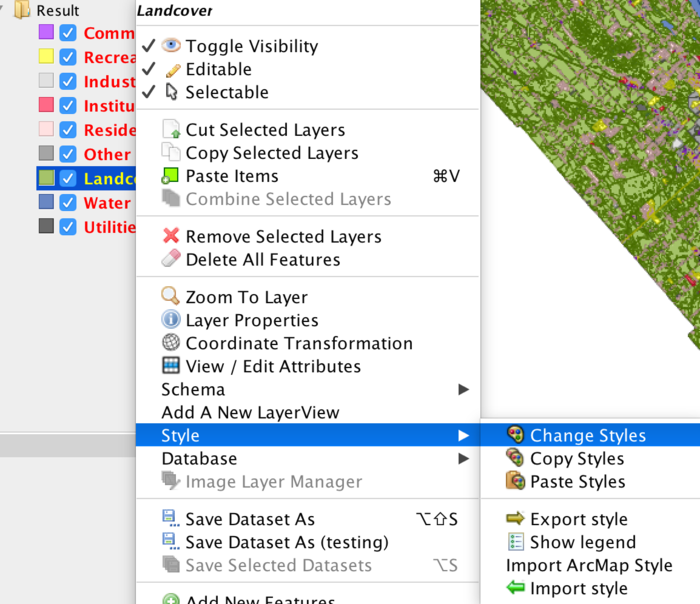
Step 8: Adding map elements
In order to add some map elements to your image, you must access the 'Printer' tool located at the upper right side of the display. From there, you can add a title, scale, border, north arrow, legend and more by clicking on the 'Furniture' button.
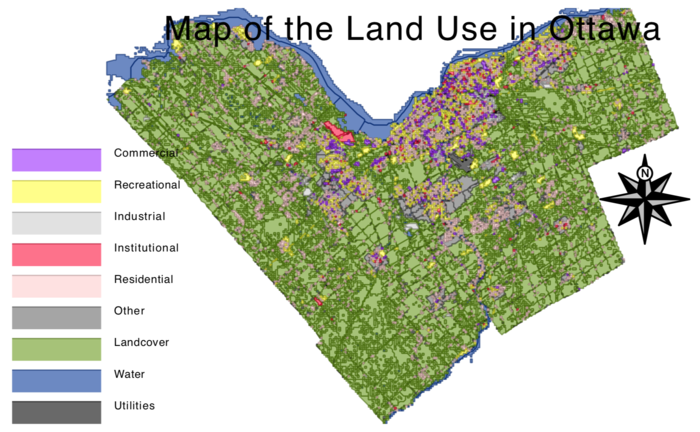
Styled Layer Descriptor
Since shapefiles in general do not store visual elements, once a GIS software is closed and reopened all of those styling elements are deleted. The Styled Layer Descriptors (SLD) option retains style information into a layer, which can be imported and exported in OpenJUMP. These files are not only useful for maintaining style in OpenJUMP since they are written in Extensible Markup Language (XML); they are universally useful for styling webmaps. To build an SLD simply right click on the layer in the table of contents and select Style->Save Style as SLD File (red circle in Figure 1.6). From there the SLD file is stored and can be imported into a layer at any point using the Style->Import SLD File option from the same menu (blue circle in Figure 1.6).
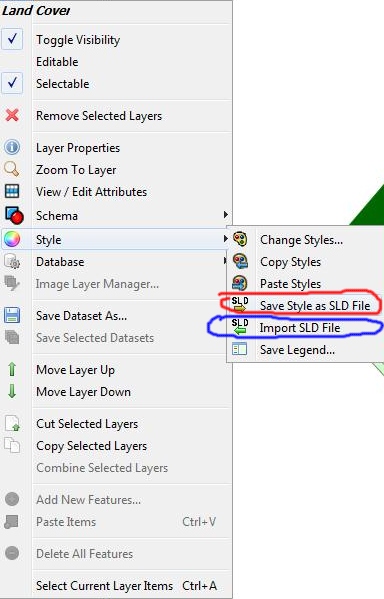
<
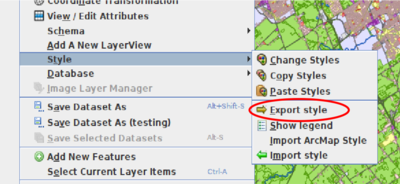
Adding an Inset Map
Inset maps are often used in thematic mapping in order to show a more dense area in greater detail, or to show the location of an area in a regional or global context. With the land use in Ottawa, an inset map is very useful in showing the more densely fragmented downtown core of the city in greater detail. Here is how you go about making one in QGIS using the layers you created in OpenJUMP.
Step 1: Saving each layer
Save and export each of the combined layers you created by right clicking on each layer and selecting 'Save Dataset As'.
Step 2: Setting up in QGIS
Open QGIS. In the Browser panel, navigate to your directory, select each layer that you just exported and drag them down to the Layers panel below. You may need to edit the colours for each layer. To do so, right click on the layer and click 'Properties'. Then select an appropriate colour in the Color field. Click ok.
Step 3: Print Layout
In the toolbar at the top of the window, click on 'New Print Layout' ![]() . Select a name for your print layout. In the toolbar on the left of the window that has just opened, click on 'Add a New Map to the Layout'
. Select a name for your print layout. In the toolbar on the left of the window that has just opened, click on 'Add a New Map to the Layout' ![]() , and click and drag your mouse over the layout viewer to cover the page. Your map should appear.
, and click and drag your mouse over the layout viewer to cover the page. Your map should appear.
Step 4: Adding your inset
Go back to the original map viewer, and zoom in on the downtown core of Ottawa. Then go back to the layout viewer, and once again click on the 'Add a New Map to the Layout' icon. This time, instead of dragging your map across the entire layout, draw your rectangle in a blank corner of your map. The zoomed in section of downtown Ottawa should appear in the inset.
Step 5: Indicating extent
In order to show the viewer which area the inset map is showing, we must indicate the extent of the inset. In the Items panel on the right side of the layout view, click on Map 1 (the overview of Ottawa). Click on the 'Item Properties' tab below, and scroll down to Overviews. There, click on the green plus sign, and select Map 2 in the Map frame field. A red rectangle should appear on your main map, showing the extent of your inset. From here you can add any map elements that you deem fit, including a title, north arrow, legend, or scale bar. You can do this by clicking on 'Add Item' at the top of the layout viewer and selecting the map elements of your choice.
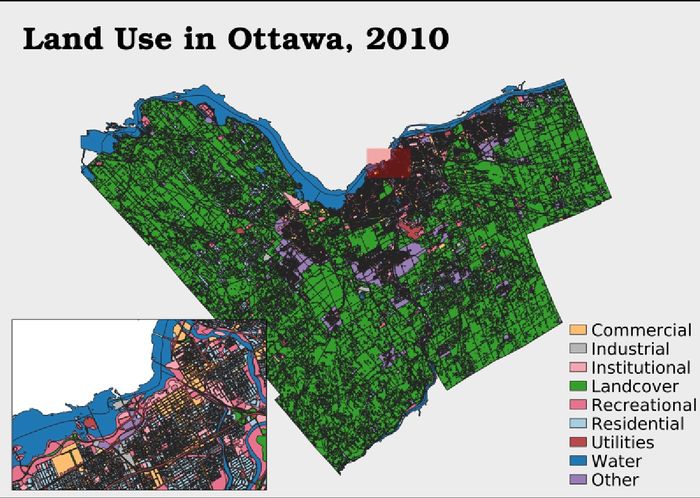
Conclusion
You are now able to successfully create a thematic map in OpenJUMP and save SLD files for future styling. With the various tools presented in this tutorial, you have now become familiar with a new open GIS software all while gaining knowledge to effectively create a thematic map.

References from: http://www.openjump.org/jpp.html https://sourceforge.net/projects/jump-pilot/